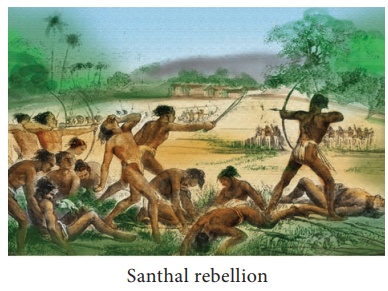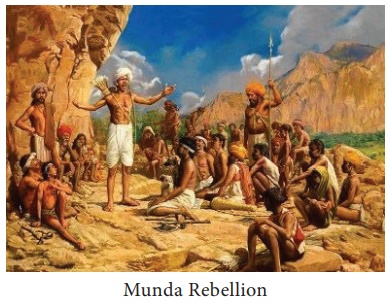Early Resistance to British Rule - Peasant and Tribal Revolts | 11th History : Chapter 18 : Early Resistance to British Rule
Chapter: 11th History : Chapter 18 : Early Resistance to British Rule
Peasant and Tribal Revolts
Peasant and Tribal Revolts
In the late eighteenth and early nineteenth
centuries the land tenures and revenue settlements of the Company’s government
had fundamentally disrupted the Indian rural society and affected the peasantry
in an unprecedented manner. In the early days of revenue farming system, the
peasantry was oppressed by the revenue contractors and company officials who
imposed high revenue demands and collected them forcibly. Initially the
peasants sent a petition to the Company’s government asking for redress. But
when their appeal for justice went unheeded, they organized themselves and
resorted to direct action. They attacked the local cutchery (revenue collector’ office), looted gain stores and
refused to pay revenue.
A peasant movement of the 1840s and 1850s was the
Malabar rebellion in present day Kerala. The Mappillas were the descendents of
Arab traders who had settled in this region and had married the Malabar women.
Gradually the Mappillais became dependent on agriculture and turned into a
community of cultivating tenants, landless labourers, petty traders and
fishermen. When the British took over Malabar in 1792, they sought to revamp
the land relations by creating individual ownership in land. The traditional
system provided for an equal sharing of the net produce of the land by the janmi (holder of janmam tenure), the kanamdar
(holder of kanam tenure), and the
cultivator. The British system upset this arrangement by recognising the janmi
as absolute owners of land, with right to evict tenants, which did not exist
earlier. Apart from that, over-assessment, a huge burden of illegal cesses and
a pro- landlord attitude of the judiciary and the police led the peasants to
live in conditions of extreme poverty.
A series of incidents therefore occurred in Malabar
throughout the nineteenth century. Three serious incidents occurred in Manjeri
in August 1849, in Kulathur in August 1851 – both in south Malabar – and in
Mattannur in the north in January 1852. British armed forces were deployed to
suppress the revolt. The repressive measures restored peace for about twenty
years, but then the Mappillas rose again in 1870 and the events followed a
similar course.
Some of the rebellions in pre-1857 India were of
the tribals whose autonomy and control over local resources were threatened by
the establishment of British rule and the advent of its non-tribal agents. The
tribal people, spread over a large part of India, rose up in hundreds of
insurrections during the 19th century. These uprisings were marked by immense
courage on their part and brutal suppression on the part of the rulers.
The Kol Uprising (1831-32)
Kols as tribals inhabited in Chotanagpur and
Singbhum region of Bihar and Orissa. The immediate cause of their uprising was
the action of the Raja of Chotanagpur in leasing several villages to the
non-tribals. The Kols of Sonepur and Tamar took the initiative in organizing a
revolt against the thikadars (tax
collectors). The forms of rebellion consisted of attacks on the properties of
the outsiders, but not their lives. Plunder and arson, were the chief modes of
peasant protest. Sonepur pargana of Chotanagpur was raided, plundered and burnt
down by a body of seven hundred insurgents on 20 December 1831. By 26 January
1832 the Kols had taken complete possession of the whole of Chotanagpur. The
revolt against the British had ended up in a war against the Company
government. Buddha Bhagat, the leader of Kol insurrection was killed in a
pitched battle. A sum of one thousand rupees was distributed among officers and
soldiers as their reward for delivering Bhagat’s severed head to the
authorities. Bhindrai Manki who inspired the revolt surrendered on 19 March
1832 and with his surrender the revolt of Kols came to a tragic end.
Santhal Hool (rebellion), 1855-56

Santhal, also
called Manji, lived scattered in various forest regions of Bengal,
Bihar, and Orissa. Driven from their homeland, they cleared the area around the
Rajmahal Hills and called it Damin-i-koh (land of Santhals). They were
gradually driven to a desperate situation as tribal lands were leased out to
non-Santhal zamindars and moneylenders. To this was added the oppression of the
local police and the European officials engaged in railroad construction. This
penetration of dikus (outsiders) completely destroyed their familiar world, and
forced them into action to take possession of their lost territory.
In July 1855, when their ultimatum to the zamindars
and the government went unheeded, several thousand Santhals, armed with bows
and arrows, started an open insurrection “against the unholy trinity of their
oppressors-the zamindars, the mahajans and the government.” At the battle of
Maheshpur, many of the Manjis were dressed in red clothes. Later this garment
became an assertion of authority. In the first week of the rising a party of
ten men attacked and burnt down the village of Monkaparrah. The rebels included
a number of women.
Initially their leader was Sido. After his arrest
the revolt was led by Kanoo. At the later stage of the revolt, the peasants
also joined. Several thousand peasants raided on Charles Maseyk’s indigo
factory and pillaged. This invited brutal counter-insurgency measures; the army
was mobilized and Santhal villages were burnt one after another with vengeance.
According to one calculation, out of thirty to fifty thousand rebels, fifteen
to twenty thousand were killed before the insurrection was finally suppressed.
Munda Rebellion

The rebellion (ulgulan) of the Munda tribesmen led
by Birsa Munda, occurred during 1899-1900. Mundas were a prominent tribe in the
Bihar region. During the British rule their system of common land holdings was
destroyed. Jagirdars, thikadars (revenue
farmers) and moneylenders grabbed the
land owned by them. Birsa, born in a poor share-cropper household in 1874,
declared himself a divine messenger to drive away the British and establish
Munda rule in the region. Under his influence the Mundas strongly opposed
non-tribals occupying tribal lands. He urged the Munda cultivators not to pay
rent to the zamindars.
Birsa Munda led a revolt in the Chotta Nagpur
region. The indiscriminate slaughter of Munda women at Sail Rakab did not deter
the followers of Birsa. The British authorities issued a warrant for Mirsa’s
arrest and put up a reward for his capture. Birsa became a martyr in Ranchi
jail (9 June 1900). His name continues to inspire the tribals of the region.
Related Topics